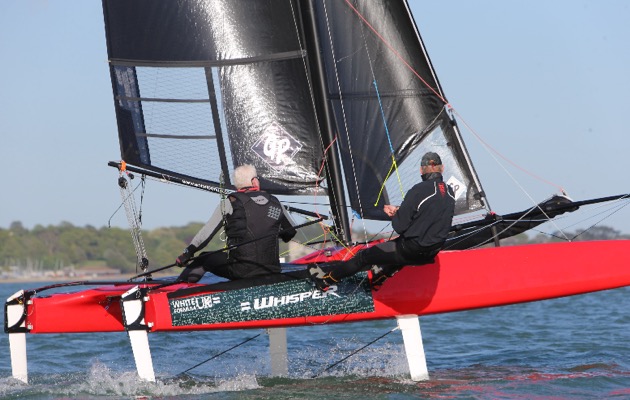Foiling for all is the aim of the White Formula Whisper, a new production catamaran which sets out to bring hydrofoils to club sailors. Matthew Sheahan gets to grips with this innovative new design and finds out whether it is realistic for us to get excited at the prospect of taking flight
“If you can sail, you can foil this boat,” said Rob White of White Formula, a company that has a long list of internationally successful production catamarans to its name including the; Dart 18, Spitfire, Shadow, Shockwave F18, Sprint 15 and many more.
But perhaps you’d expect him to say that. A lifelong cat sailor and double world champion in the Tornado class, his sailing and industry achievements place him in a position of authority when it comes to multihulls and production boat building.
“Look at the amount of people who want to sail a Moth but can’t. I count myself in that too,” he continued. “The Moth is tricky to sail, while the current production foiling cats are too expensive for most people. They can also be quite difficult to sail.”
The Formula Whisper that is built by White’s performance catamaran business is an all-carbon production version of the 6.2m hydrofoiling Solent Whisper prototype that did the rounds at several boat shows last winter where she turned plenty of heads at Southampton and London, while also attracting a great deal of interest overseas at the Paris show. Indeed, so much interest that just a few months later 27 boats had been sold to customers in six countries including the USA and New Zealand. This, claims her builder, is just the start.
“We’ve been thinking about producing a foiling cat for years and there’s no question that the last America’s Cup spurred everyone on. But it was this design that impressed us and made us think that the time was right.”
White freely admits that it was not his company’s design that has led to the new production boat. Instead the foiling cat started life as a personal project for Ron Price who is both a regular 49er sailor and Senior Lecturer in naval architecture at Southampton Solent University.
“Like so many other people I was blown away by the America’s Cup foiling cats and wanted to have a go myself,” he explained. “But it was clear that I wasn’t going to get a ride on one of these machines so I set about designing a foiling cat of my own.”
While the motivation to fly was the same, Price’s starting point was fundamentally different. Instead of using a set of ‘V’ section dagger boards to provide the vertical lift, as is the case with the Cup boats and production foiling cats such as the Flying Phantom and Nacra F20, Price used the T-foil concept that is used in the International Moth.
Here, a moving flap attached to the trailing edge of the horizontal foil alters the amount of vertical lift that is generated. This flap is mechanically connected to a wand that skims the water’s surface monitor the ride height. Too low and the flap increases the angle and hence T-foil lift, too high and the flap’s angle is reduced, which in turn reduces the lift generated.
In theory having all four foils in the water should make for a very stable platform, one of the key features that Price and White believe makes this boat more suitable for club sailors to get to grips with.
By Price’s own admission, the Whisper is unlikely to be the quickest foiling boat out there, but she is still capable of keeping pace on a two sail reach with a Moth. For most of us that would be easily fast enough to scratch the itch. And she doesn’t cost the earth either, especially when you consider that she’s an all carbon boat. With a price tag of £19,500 complete and incl VAT she’s an appealing prospect.
But does she work?
In the August issue of YW, (out 9 July), I take a close look at what makes this innovative boat tick while discovering whether it really is possible for an extra-medium, middle aged man to learn to fly in an hour rather than the years it might take in a Moth.




